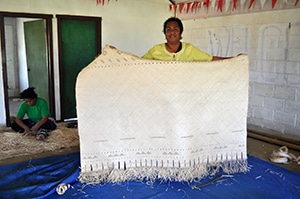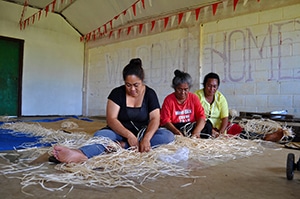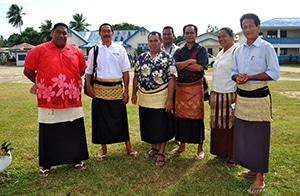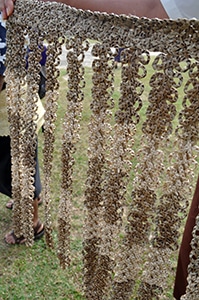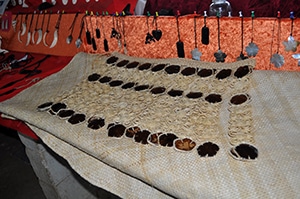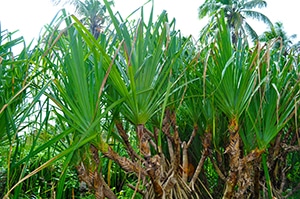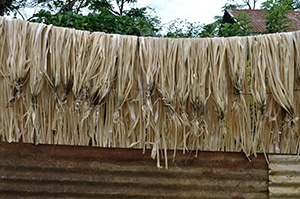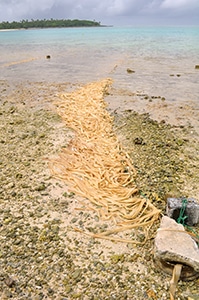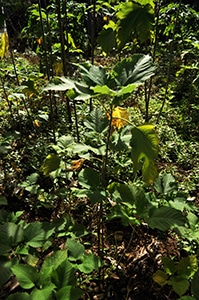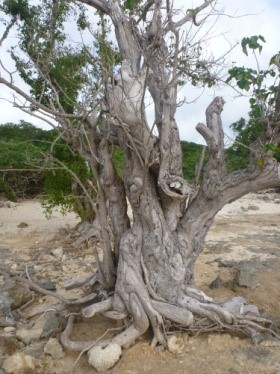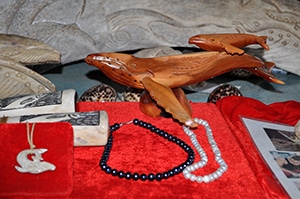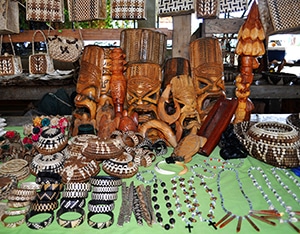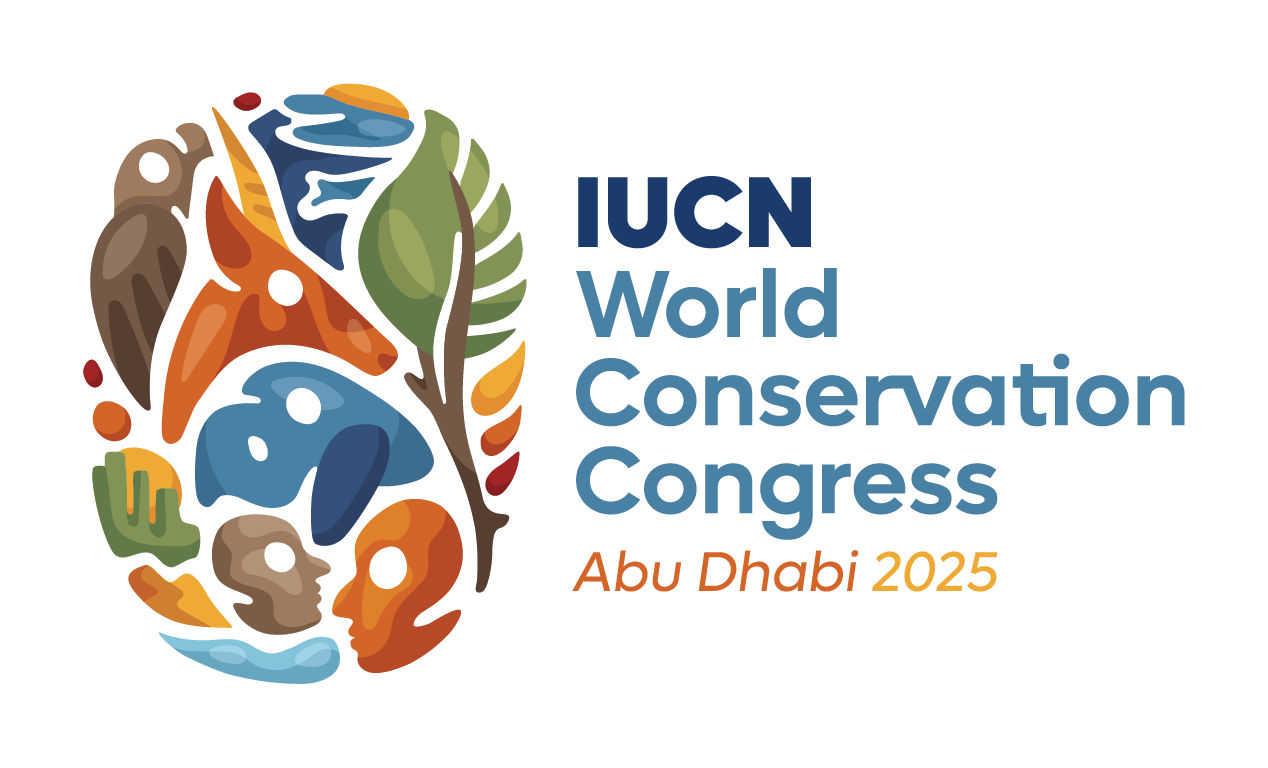Today we are near Ovaka in the Vava’u Island group. The sky is blue, the sun is out, and the scuba diving is incredible. During the morning dives, a couple of members of the Science Team saw two octopi only feet away from them. They seemed to be investigating the SCUBA divers. All around it was a wonderful start to the day.
Tongan Handicrafts
For thousands of years, Tongans have been making handicrafts. Even today with modern technology, the market favors these handmade items. Handicrafts are still a large part of the Tongan culture, and in many islands, this is still a major source of income. Tongan handicrafts are made on the outer islands and they are sold locally and shipped by ferry to tourist shops in Tongatapu, the main island. Often handicrafts are preordered from Tongans living abroad.
Tongan Handicrafts being made in Vava’u Island Group.
Mat Weaving
Mat weaving is one of the ancient Tongan handicrafts. The mats are used for a variety of purposes. Woven mats are commonly used for bedding and flooring. They are also presented at special occasions such as births, deaths, and weddings. Mats are often passed down from generation to generation and historically, they were a symbol of social status. In death, Tongans are wrapped in mats as a sign of respect.
Women in Talihau Island weaving mats.
The mats are also worn as a taʻovala, which is a mat worn around the waist. Wearing the ta’ovala is also seen as a sign of respect. It is said that in early times, men returning from a long voyage at sea would cover up with these mats before visiting the chief of the village. Ropes are made out of braided coconut husk are wrapped around the ta’ovala just like a belt, and are another one of the Tongan handicrafts.
Here the men are wearing traditional taʻovalawith woven ropes. The women is wearing akiekie, a fundamental part of Tongan culture.
Women often wear a modified version called the kiekie. There are many styles and different materials used to make them. Each island group has different materials that they fashion them out of and by looking at the kiekie, it is easy to determine where someone is from, making it a fundamental part of Tongan culture. For example, Ha’apai has very colorful kiekie, which is unique to that island group. Often in Vava’u, the kiekies are decorated with polished coconut shells.
Here is a kiekie that has been woven out of two types ofpandanus leaves.
Here is an example of a kiekie from Vava’u. Notice the polished coconut shells that have been integrated into it.
Mats are woven out of pandanus leaves or lo’akau. Different leaves have different colors. Here are the main pandanus leaves used: paongo (brown), tofua (light brown), kie (white), and tapahina (white stripes).
Pandanus leaves are used to in mat weaving.
The different species of pandanus leaves are prepared differently. Here is an example of how kie leaves are processed. First, the leaves are boiled to get rid of the outer layer. Next, the leaves are secured to a rope and set in the ocean to soak for days. They are secured by large rocks or cinder blocks. Soaking the pandanus in the ocean allows for the leaves to become bleached and make the leaves softer, therefore, making it easier to work with them when mat weaving. When removed from the seawater, the leaves are rinsed in fresh water and then they are dried in the sun. After the leaves are dry, they can be woven into a mat. Large mats (as big as 20 x 10 feet), can take days to make, but finely woven mats (using a thinner pandanus) can take weeks to make.
Pandanus being dried after processing.
The kie leaves are being bleached in the ocean.
A natural way to dye the pandanus black was to soak them in mangrove mud and then boil them with the leaves of manaui (Garuga floribunda) or loa ano (Jussiaea erecta). With modern dyes, mats can come in variety of colors, though most mats are still made the traditional way, without dyes.
Tapas
Tapas are the art of making cloth from the bark of trees, and they are the most valued of the Tongan handicrafts. Tapas are often painted with animals and/or geometric designs. They are used as decoration in the home; however, they are also worn during weddings and burials, making them an important part of Tongan culture. During burial services, people are first wrapped in a tapa and then a mat.
Tapas are made out of the mulberry trees known as hiapo. The trees are grown on plantations and in people’s back yards. When making tapas, the tree is cut down and stripped of its’ bark. The outer layer of bark is discarded and the inner layer is dried in the sun. After it’s dried, it’s soaked overnight in water. The following day the wood is beaten with a mallet called an ike. When the layer is thin and if a larger tapa is desired, then multiple pieces can be pounded together. If they will not stick together, tapioca (sometimes called cassava) root is used like a glue to hold them together. A typical tapa usually consists of two layers to increase the thickness. Once the cloth is flattened and dried then the design can be painted on it.
A young mulberry tree – they are used to make tapas, one of the most valued of the Tongan handicrafts.
There are several types of trees that produce dyes for painting the tapas: koka (red cedar), Tongo ta’ane (black mangrove), and tuitui (candlenut). The dye is painted on using the seed of a pandanus tree. Traditionally for Tongan handicrafts, dyes are brown, unlike their neighboring country, Fiji, which uses black dyes.
Wood and Bone Carving
Historically, wood and bone carving were an important part of the Tongan culture. Men carved wood making bowls, head rests, log drums (used for calling people to and event such as church or feast), war clubs, kava bowls, canoes and paddles, spears, fish hooks, etc. Today, wood carvings such as masks, clubs, animal figurines, and kava bowls are sold as Tongan handicrafts. Kasia wood, Milo (Thepesia populnea), and Casuarina (ironwood) are harvested for carving.
Milo (Thepesia populnea) tree used to make wooden carvings.
Examples of wood and bone carving: Photographed is a wooden humpback whale carving and to the left is a carved humpback whale bone. The women were also sell pearl jewelry.
Animal bone is also used for carving. Women make different types of jewelry such as bracelets, necklaces, and earrings out of bone. Figurines and fish hooks are commonly crafted. Cow bones are primarily used for carving; however, beached whale bones are also used. They are sold at a higher market value due to their rarity.
Here is a variety of wooden carvings, and purses and jewelry made out of pandanusleaves.
In Nieafu, Vava’u, we were able to visit a market where Tongan handicrafts, fruits, and vegetables were sold. The handicrafts were intricate and diverse in styles and colors pleasing all who visited and representing the diversity of Tongan culture.
Photos: 1-8; 9-12 Amy Heemsoth; 9 Hoifua ‘Aholahi

